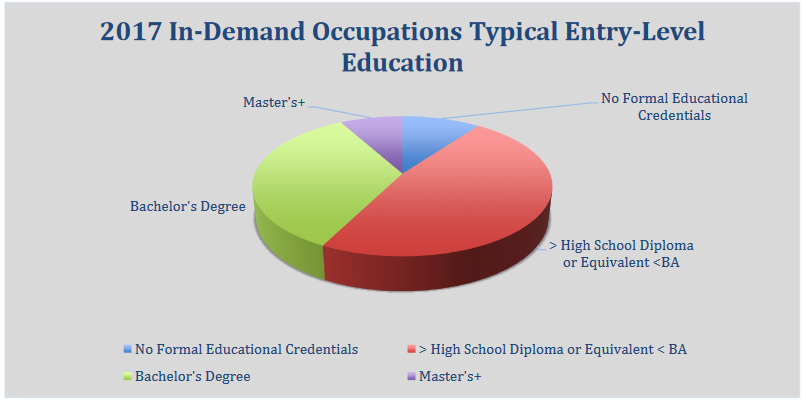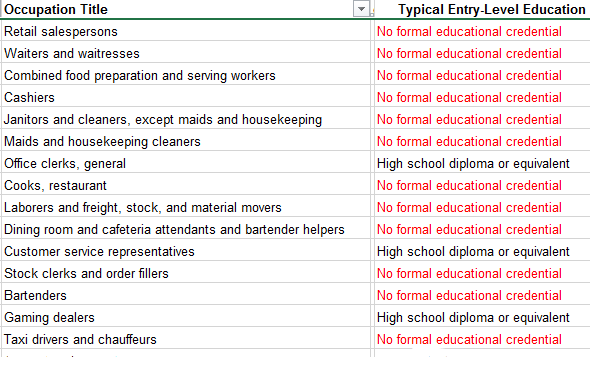Excuse me for a sec, but…
EDUCATION IS GOOD!
I AM NOT SUGGESTING THAT EDUCATION IS UNNECESSARY, IRRELEVANT OR BAD IN ANY WAY!
ECONOMIC DIVERSIFICATION IS ALSO GOOD!
I feel I had to go all caps, like an old man yelling on the internet (ok, I am an old man yelling on the internet) because my prior experience with writing or talking about Nevada job projections (which I am about to do, again) has invariably been met by at least a few people who miss my point, which is:
NO MATTER HOW WONDERFUL OUR EDUCATION SYSTEM OR HOW MUCH WE DIVERSIFY THE ECONOMY WE ARE ALWAYS GOING TO HAVE A WHOLE BUNCH OF JOBS IN NEVADA THAT WILL SUCK SO WE SHOULD MAKE IT SO THEY DON’T SUCK SO BAD BY PAYING PEOPE MORE AND PROVIDING THEM WITH BENEFITS AND OTHER NICE THINGS!
And with that out of the way, I will now write about job projections. Again.
***********
Alan Schlottman, an economist at UNLV, published a piece in the Nevada Independent on “the myopia of higher education.” It’s brief and you should read it, but the nutshell is that Nevada’s universities are pushing graduate degrees when the actual gap between education and “in-demand jobs” in Nevada is for “middle-skill” jobs, that is, jobs that require some training beyond high school but short of a bachelor’s degree. He singles out UNLV specifically, perhaps referring to its crusade to reach top tier research status, but in any case, what’s needed ’round here is a “realignment in higher education priorities,” Schlottman concludes.
While there are many Nevada higher education priorities I would like to see realigned, reconsidered and/or incinerated by flamethrower, Schlottman’s particular concern is, for the most part, a fight in which I do not have a dog. But this chart, which accompanied his piece, caught my eye:
 The chart is from a January report put together by the Governor’s Office of Workforce Innovation for a New Nevada (OWINN) in partnership with the Governor’s Office of Economic Development (GOED) — two pillars of Nevada’s workforce development industrial complex — and the state Department of Employment, Training and Rehabilitation (DETR) Research and Analysis Bureau — which is a straight-up numbers shop in a perfect world but a Brian Sandoval public relations agency in ours.
The chart is from a January report put together by the Governor’s Office of Workforce Innovation for a New Nevada (OWINN) in partnership with the Governor’s Office of Economic Development (GOED) — two pillars of Nevada’s workforce development industrial complex — and the state Department of Employment, Training and Rehabilitation (DETR) Research and Analysis Bureau — which is a straight-up numbers shop in a perfect world but a Brian Sandoval public relations agency in ours.
T’was the blue piece o’ pie that caught my eye – “in-demand occupations” requiring “no formal education credentials,” i.e., less than high school. “When examining the typical entry-level education of only the 2017 top in-demand occupations in Nevada,” the report said, “…only 10 percent of the in-demand occupations require no formal education.” And the report assumes the number of “in-demand occupations” requiring no formal credentials will get smaller as the economy diversifies.
In other words, OWINN envisions a Nevada future filled with “in-demand” jobs requiring post-high school credentials — and presumably those jobs will come with higher pay and better benefits. And that means we need to tailor the goals and programs in our education system accordingly.
Seems fair enough… as far as it goes…
*******
The OWINN report identified and ranked “in-demand occupations” after merging several “data sets” ranging from official projections to a private firm that counts want-ads. The process also involved industry “Sector Councils … voting on the occupations they believed are priority occupations in relation to economic development and diversification based on labor market data and their industry experiences.”
In other words, the OWINN report doesn’t identify which Nevada occupations are going to need the most humans to fill them — that is, the genuine occupations in which there will be the most openings. A report on “in-demand occupations” isn’t about the occupations that will numerically be most in demand.
Instead, the report identifies what people in the workforce development subculture, in conjunction with business, have declared to be “in-demand jobs” — which might be interpreted as occupations industry expects to have trouble filling since they require particular skills and/or training for entry.
And that’s OK! As the OWINN report explains, the aim is to “provide a level of information and security for students and adults engaging in various career pathways and spending precious time, energy and financial resources to make informed decisions and understand the consequences of the choices they make when pursuing skills and training.”
But the report is not and, however inadvertently, should not be portrayed or construed as an accurate projection of which jobs will have the most openings in Nevada. According to Bureau of Labor Statistics projections through 2024 (one of the harder “data sets” used in the OWINN report), which DETR helpfully enters into an excel file, those jobs, and the typical education level required for entry, will be:

Nodding to a previous DETR projection, the OWINN report acknowledges that it knows this. I had a conversation with Manny Lamarre, OWINN’s director, who also gets it. Yes, job openings may be led by low-skill occupations numerically, but those occupations do not demand more in terms of, for instance, training for entry, the sort of thing the OWINN study tries to identify, Lamarre said.
And again, that’s great. Presuming a decent wage is something that will exist in the future, Nevada students and parents should absolutely have as much information as possible about where they might find one.
The problem is that the OWINN report contributes to the impression, persistently fostered by Sandoval and his sprawling workplace development apparatus and routinely echoed in the press, that the overwhelming majority of jobs opening up are going to be, well, special, and require advanced training, so workplace development (which would include employee engagement, proper and constructive feedback and opportunity to grow in the respective field) simply must be our top priority as we prepare for the “new Nevada.”
Meantime, in the real Nevada, the top six, and 12 of the top 15, occupations that will have the most average annual openings through 2024 require “no formal educational credential” for entry. If you filter the aforementioned DETR excel file by education level, low-skill occupations totaled are projected to account for 38% of job openings in Nevada. When those low-skill jobs are combined with occupations requiring “high school diploma or equivalent,” together they account for 61 percent of all projected job openings through 2024.
That — not some mid-level skills gap — is the workforce data that is routinely, aggressively, even deliberately shunted aside around here.
*********
NO! THAT ABSOLUTELY DOES NOT MEAN THAT EDUCATION IS UNNECESSARY, IRRELEVANT OR BAD IN ANY WAY! EDUCATION IS GOOD!
AND YES! ECONOMIC DIVERSIFICATION IS GOOD TOO!
But led by the governor and his assorted workforce development agencies, Nevada’s “stakeholders” in business, education, politics etc. often pretend that low-skill, low-pay jobs are just going to disappear. The governor’s office said as much when throwing shade on proposals to raise the minimum wage, a specious argument that I’ve disposed of elsewhere.
The truth is low-pay, low-skill jobs will continue to account for at least a third of all the jobs filled by working Nevadans for the foreseeable future, and neither economic diversification nor the growth of “in-demand” jobs is going to fix that. Again, economic diversification is great. But no matter how much we diversify, there will still be hundreds of thousands of Nevadans working in low-paying jobs because those are the jobs we are going to have (and it’s not just a Nevada thing).
The consequences of Nevada’s actual, numerical workforce demand data are far more problematic than the ramifications of some gap between workplace skills and the occupations anticipated in Sandoval’s “new Nevada.” Structural poverty and its attendant insecurity, instability and horrors won’t be fixed by training and education and workforce development, but by better wages and improved working and living conditions. Nevada policymakers have directed orders of magnitude more focus on the training and education part. Yet the wages and conditions part is orders of magnitude more urgent. It is also much, much more politically difficult to address, which is why Sandoval & Co. would rather draw attention to their hopes than face the facts.